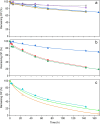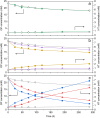Enzymatic synthesis of Hydroxytyrosol from Oleuropein for valorization of an agricultural waste
- PMID: 39235136
- PMCID: PMC11382736
- DOI: 10.1080/21655979.2024.2396647
Enzymatic synthesis of Hydroxytyrosol from Oleuropein for valorization of an agricultural waste
Abstract
Oleuropein (OP) is an appreciated compound present not only in fruits but also in leaves of olive trees, which can be transformed into hydroxytyrosol (HT), a substance with high antioxidant activity. In this work, the transformation of an agricultural residue containing OP (olive leaves or wastewater from mills) to the high added value compound HT is accomplished through different enzymatic strategies. Different enzymes were used, immobilized on various supports by diverse binding forces: beta-glucosidase encapsulated in siliceous material, esterases and lipases immobilized on hydrophobic supports (octyl-functionalized amorphous silica and periodic mesoporous organosilica), and esterase immobilized on amine-functionalized ordered mesoporous silica. All these biocatalysts were tested for oleuropein hydrolysis through two different reaction approaches: a) split of glucosidic bond catalyzed by beta-glucosidase (β-glu), followed by hydrolysis of the aglycon and further ester hydrolysis. 5 mg·mL-1 of β-glu fully hydrolyzed 5 mM OP at pH 7 and 50°C in 7 days, and further enzymatic hydrolysis of the aglycon yielded near to 0.5 mM HT in the best conditions tested. b) via direct hydrolysis of the ester bond to produce hydroxytyrosol in a one-step reaction using esterases or lipases. The latter reaction pathway catalyzed by lipase from Penicillium camemberti immobilized on octyl-silica (4 mg·mL-1) at 35°C and pH 6 directly produced 6.8 mM HT (1 mg·mL-1), transforming in 12 days near to 30% of the initial 25 mM OP from a commercial olive leaves extract.
Keywords: Oleuropein; enzymatic transformation; hydroxytyrosol; immobilized enzymes; waste valorization.
© 2024 The Author(s). Published by Informa UK Limited, trading as Taylor & Francis Group.
Conflict of interest statement
No potential conflict of interest was reported by the author(s).
Figures










References
Publication types
MeSH terms
Substances
LinkOut - more resources
Full Text Sources
Other Literature Sources
Miscellaneous
